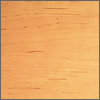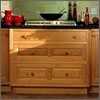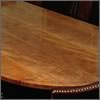|
|
||||
|
|
American soft maple (Principally Acer rubrum, A. saccharinum)Other names: Red maple, silver maple
Click to enlarge DistributionThroughout Eastern USA, and to a lesser extent on the West coast (bigleaf maple). General descriptionIn most respects the wood of soft maple is very similar to that of hard maple. Although due to its widespread growth it may be more susceptible to regional colour variations. Generally the sapwood is greyish white, sometimes with darker coloured pith flecks. The heartwood varies from light to dark reddish brown. The wood is usually straight grained. The lumber is generally sold unselected for colour. Working propertiesSoft maple machines well and can be stained and polished to an excellent finish. It glues, screws, and nails satisfactorily. It dries slowly with minimal degrade and there is little movement in performance.
Physical propertiesSoft maple is about 25% less hard than hard maple, has medium bending and crushing strength, and is low in stiffness and shock resistance. It has good steam bending properties. Specific Gravity: 0.54 (12% M.C.) DurabilityNon-resistant to decay and insect attack. The heartwood is moderately resistant to preservative treatment but the sapwood is permeable. AvailabilityUSA: Readily available as lumber and veneer. Main usesFurniture, panelling, interior joinery, kitchen cabinets, mouldings, doors, musical instruments, and turning. Soft maple is often used as a substitute for hard maple or stained to resemble other species such as cherry. Its physical and working properties also make it a possible substitute for beech.
|
|
||||||||||||||||||||||||||||||||||||||||||||||||||||||||||||||||||||||||||||




